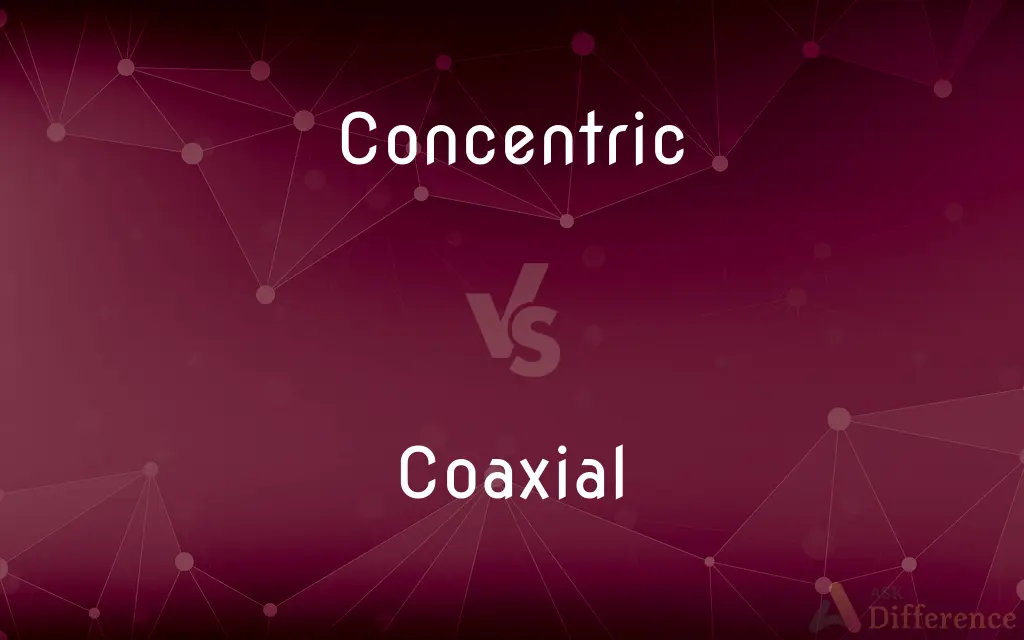Concentric vs. Coaxial — What's the Difference?
By Maham Liaqat & Urooj Arif — Updated on March 26, 2024
Concentric refers to shapes sharing a common center, emphasizing uniformity in radial distance, whereas coaxial involves alignment along a common axis, focusing on directional harmony.

Difference Between Concentric and Coaxial
Table of Contents
ADVERTISEMENT
Key Differences
Concentric shapes are characterized by having multiple layers or circles that share the same center point, showcasing symmetry in all directions. On the other hand, coaxial configurations involve components, wires, or geometries aligned along the same axis, highlighting a linear relationship rather than radial symmetry.
While concentric designs are often found in targets, ripples in water, and architectural elements, emphasizing radial balance and equal spacing, coaxial arrangements are critical in electrical engineering, cable designs, and mechanical systems, prioritizing parallel alignment for functional coherence.
Concentricity is a concept widely utilized in design and aesthetics, where the visual and structural harmony of elements radiating from a common center is paramount. Whereas coaxiality is crucial in ensuring the efficient transmission of signals and forces along a straight path, optimizing performance in technological and structural applications.
In art and design, concentric patterns can create a sense of movement and focus, drawing the viewer’s eye inward or outward from the center. Coaxial arrangements, however, are pivotal in communication technologies, where cables and components must align perfectly to minimize signal loss and maintain integrity over distances.
The choice between concentric and coaxial configurations often depends on the specific requirements of a project or application, with concentricity favored for its aesthetic and balanced appeal, while coaxiality is selected for its practical efficiency in linear transmissions and connections.
ADVERTISEMENT
Comparison Chart
Definition
Sharing a common center
Aligned along a common axis
Primary Use
Design, aesthetics, architecture
Electrical engineering, communications
Symmetry Type
Radial
Linear
Example Objects
Dartboards, archery targets
Coaxial cables, coaxial connectors
Key Advantage
Aesthetic balance and harmony
Efficient signal transmission
Compare with Definitions
Concentric
Design principle emphasizing radial symmetry.
The garden's concentric layout enhances its peaceful aura.
Coaxial
Employed in electrical and mechanical systems.
Coaxial rotors in helicopters provide stability and control.
Concentric
Often used in target designs.
The concentric rings on the target helped improve the archer's accuracy.
Coaxial
Referring to objects aligned along a common axis.
Coaxial cables are used to connect antennas to TVs.
Concentric
Found in natural and man-made structures.
The concentric layers of an onion reveal its growth pattern.
Coaxial
Crucial in signal transmission.
The coaxial design ensures minimal signal interference.
Concentric
Relates to balance and harmony.
The concentric circles in the design symbolized unity and continuity.
Coaxial
Used in scientific instruments for precision.
Coaxial microscopes adjust focus without shifting the viewpoint.
Concentric
Characterized by having a common center.
The artist painted concentric circles with vibrant colors.
Coaxial
Having or mounted on a common axis.
Concentric
Having a common center.
Coaxial
In geometry, coaxial means that several three-dimensional linear or planar forms share a common axis. The two-dimensional analog is concentric.
Concentric
(geometry) Having a common center.
Coaxial
(geometry) Having a common central axis
Concentric
(physiology) (of a motion) in the direction of contraction of a muscle. (E.g. extension of the lower arm via the elbow joint while contracting the triceps and other elbow extensor muscles; closing of the jaw while flexing the masseter).
Antonym: eccentric. Concentric and eccentric movements are collectively referred to as isotonic (with motion), the antonym of which is isometric (without motion).
Coaxial
A coaxial cable
Concentric
Having a common center, as circles of different size, one within another.
Concentric circles upon the surface of the water.
Concentrical rings like those of an onion.
Coaxial
Having a common axis.
Concentric
That which has a common center with something else.
Its pecular relations to its concentrics.
Coaxial
Having a common axis
Concentric
Having a common center;
Concentric rings
Coaxial
Indicates linear alignment for functional coherence.
The coaxial speakers offer a compact and efficient design.
Common Curiosities
What are coaxial cables used for?
Coaxial cables are used for transmitting electrical signals without interference, commonly in TV and internet connections.
What is the importance of concentric designs in architecture?
In architecture, concentric designs are important for creating visual harmony, balance, and guiding movement within spaces.
Can a design be both concentric and coaxial?
While a design might incorporate both principles, they describe different types of alignment—radial vs. linear.
Are concentric designs common in nature?
Yes, many natural forms, such as tree rings and ripples in water, display concentric patterns.
How do coaxial systems benefit audio and video quality?
By maintaining a consistent transmission path, coaxial systems can deliver superior audio and video quality with minimal loss.
What does concentric mean?
Concentric means having a common center, as seen in circles or spheres that are perfectly aligned radially.
How do concentric circles differ from coaxial cables in application?
Concentric circles are often used in designs and aesthetics for symmetry, whereas coaxial cables are practical tools in signal transmission.
What industries rely heavily on coaxial technology?
The telecommunications, broadcasting, and internet service industries rely heavily on coaxial technology for efficient signal transmission.
Do concentric shapes have any special significance in culture or symbolism?
Yes, concentric shapes often symbolize unity, wholeness, and the cycle of life in various cultures and spiritual practices.
Can concentric patterns affect one’s perception of space?
Yes, concentric patterns can draw the eye inward or outward, affecting the perception of space and depth.
Is there a mathematical significance to concentric shapes?
Yes, concentric shapes are studied in geometry for their properties of symmetry and balance around a common center.
How does the principle of concentricity apply to urban planning?
In urban planning, concentricity can influence the design of communities, traffic flow, and public spaces for enhanced livability and aesthetic appeal.
Why are coaxial cables preferred for high-frequency transmission?
Coaxial cables are preferred for their ability to minimize signal loss and electromagnetic interference, making them ideal for high-frequency transmission.
How does coaxial alignment enhance signal quality?
Coaxial alignment reduces signal dispersion and interference, ensuring higher quality and more reliable signal transmission.
What makes coaxial connectors unique?
Coaxial connectors are designed to maintain the coaxial form through connections, preserving signal integrity.
Share Your Discovery

Previous Comparison
Absinthe vs. Mugwort
Next Comparison
Bluff vs. ButteAuthor Spotlight
Written by
Maham LiaqatCo-written by
Urooj ArifUrooj is a skilled content writer at Ask Difference, known for her exceptional ability to simplify complex topics into engaging and informative content. With a passion for research and a flair for clear, concise writing, she consistently delivers articles that resonate with our diverse audience.













































